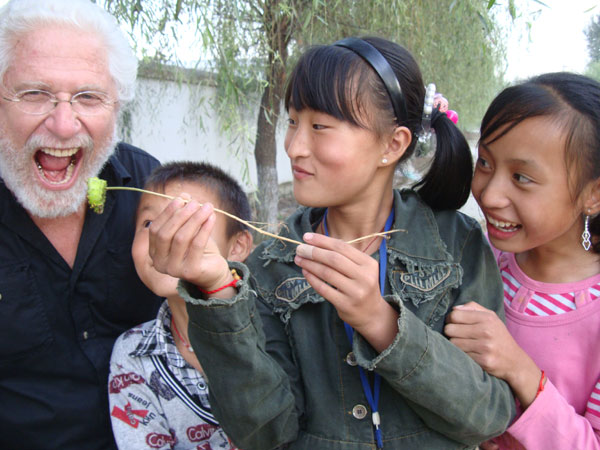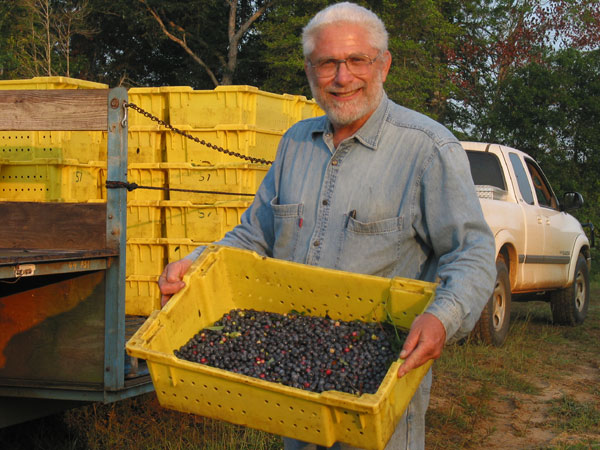
A Texas blueberry grower finds a lot to like in China as he helps give a boost to a new industry, as Mike Peters discovers.
Most Westerners who visit China for the first time are overwhelmed by how different the country is from their own. For 59-year-old Henry Sunda, though, a lot of his experience in Shandong has been rather familiar, although not the same. In 1988, when Sunda first started growing blueberries in his native East Texas, it was a new idea in that part of the US. He retired from managing a 9,000-acre (3,642-hectare) mixed farm in 2010, but he's not been fishing or playing golf. For the past two years, he's been working with Chinese farmers in Shandong province's tiny Xihue Village. His mission: to expand production of the tiny, sweet "superfruits" in a new industry that's seeing explosive growth here.
 |
|
Villagers in Xihue tempt Henry Sunda with unexpected snacks, including a silkworm. Photo Provided to China Daily |
Of course, not everything was like back home.
"It was a step back in time to live with the farmers," he says. "They had electricity and running water but beyond that not a whole lot. I would say the living conditions were similar to rural East Texas in the 1920s, although electricity didn't arrive (there) until the 1950s.
"At home I live in a very rural setting - literally at the end of the power line, with my nearest neighbor one mile away. So here I have been very aware of the numbers of people living and working in such close proximity to each other," says Sunda.
"The villages are compact and the individual farms and gardens immediately outside the village proper are immaculate and well-tended. The tools are simple. The older folks still use hand carts and water buffalo, while the younger generation use the very utilitarian two-wheel motorized tractor for hauling incredible loads of brick, tilling, plowing and pumping water to their fields," he adds.
 |
|
Sunda expects China's blueberry market to be very lucrative in the next decade. |
Sunda has enjoyed China since his first visit to the Nanjing area in 2008, when he was fascinated by the culture, the monuments, the gardens and, of course, the many people.
He had accompanied horticulturist David Creech to China for a series of agriculture exchanges with experts from Nanjing and Creech's home base, Stephen F. Austin University in Nacogdoches, Texas. Creech, who had been hired to help develop the Texas blueberry field, was the recruiter this time.
Last fall, Sunda was on his way to China again: to Xihue village as a consultant for a budding blueberry operation there.
"I felt comfortable on the streets any time of the day or night," he says. "I had some exposure to Chinese agriculture along the road sides where crops were grown up to the edge of the pavement - even inside the cloverleafs of highways."
Back at home, Sunda got his start in agriculture managing a pine timber farm for an old family trust, which also cultivated white-tail deer for hunting and developed some gas wells on its more than 3,600 hectares.
Some of that land was poorly suited for growing pine trees, so the farm owners were eager to find other uses for what locals called "sugar sand" - deep, sandy, nonproductive soils.
Impressed by a visit to a flagship blueberry farm in the region, Sunda and his team planted 50 acres of blueberries. Since then, that field has grown by 30 percent, and lots of farmers in East Texas have added blueberries to their mix of crops.
The new field was soon the largest producer in the state and began hosting a blueberry festival that draws large crowds every year.
Growers, agriculture experts and foreign investors came to tour the site, including delegations led by the Nanjing Botanical Garden and the Nanjing Forestry University between 2006 and 2008.
That led to a partnership in urban forestry and horticulture that's prompted Chinese experts to visit the US every year since, while both Creech and Sunda have earned a ton of frequent-flier miles coming the other way.
The blueberry operation around the Xihue village is spread over four parcels of land. The first parcel, planted in 2010, was harvested for the first time this year. That three-year wait may have been the biggest learning curve for local farmers who had been growing traditional crops of the area (corn, peanuts, yellow beans and wheat), and getting a harvest from the first year.
Sunda also coped with a harsh winter this year, which meant fewer blueberries went to market than he'd hoped, and challenges in soil nutrition, irrigation, plant-variety selection and the range of elevation.
"The topography of the area ranges from fairly steep, gravelly hillsides to loamy rolling hills," he says.
But you cultivate the plant the same way no matter where it is grown - and the effort, he insists, is well worth it.
"The demand for blueberries way outstrips the supply in China and this will continue for quite a while, perhaps 10 years as it did in the States," he says. "The profits will be exceptional during that period. After that, blueberries will become more of a commodity such as apples and pears. So there is a window of opportunity for those bold enough to jump off into this capital-intensive crop and not cut corners."
"Small farms will have a hard time because of the logistics of getting the somewhat fragile berries to market in good condition," he says, and they may need to band together into Western-style coops to share facilities and costs for cleaning, packing, marketing and distribution of their berries.
"My guess is that blueberry orchards in China will remain the domain of investment groups for many years to come with orchard sizes starting at 700 mu (47 hectares) and up."
Sunda says this was the first year he actually ate a blueberry in China, and that was from the farm he was working at.
"The berries didn't taste any different than what is grown back home in East Texas, delicious! I thought I might see a few blueberries surface at some of the banquets I have been privileged to attend but nothing yet.
"My traveling companion Fran was asked to help bake some blueberry cupcakes for the 'pick-your-own fruit' store at our field, which was a challenge as ingredients for such things (baking powder) are understandably not common in China."
But he was happy to take China on its own terms, and being from a rural area he adapted easily to some of the inconveniences his new neighbors faced, such as loss of Internet and occasionally electricity.
"And the flies provide a lot of entertainment 24 hours a day," he says. "The Chinese flies are much smarter and faster than their counterparts in the US. They wait patiently at the door to come in. Once inside, their evasive tactics include high speed mid-air maneuvers that are very difficult to track while stealth operations involved floor and ceiling deployments where they were either hard to see or out of reach.
"I was also impressed with the fly swatters here that have an extra-long, stout bamboo handle that helps combat these evasive tactics.
"Fran and I enjoyed visiting the local street markets. Fresh red meat - pork, goat and an occasional water buffalo - was always available, but no beef. Market day in the village was heralded by the squeal of a pig at 3 am as it was slaughtered for sale that day. Chicken and fish are generally held live until a customer comes along and points a finger.
"It goes without saying that the vegetables and fruits on sale were locally grown and in season. As far as freshness, you can't get much fresher than a village market in China."
Contact the writer at michaelpeters@chinadaily.com.cn.